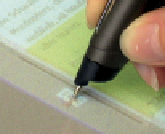Information Technology Reference
In-Depth Information
added or removed physical document. The same gesture applies if a user wants to
add or remove a digital document.
Summing up, the conceptual activity of creating links combines up to three core
interactions of our model. These are
inking
,
combining
and
bridging
. It moreover
illustrates the principle of
spatial multiplexing
: the generic association gesture has
different meanings depending on the area it is performed upon. Finally,
gestural
multiplexing
enables to differentiate between creating associations and defining sub-
document scopes.
Following Hyperlinks
A hyperlink is followed by tapping on or near a link marking (the gesture or the
human-readable reference) in an association area (Fig. 6.9). This is possible on a
printed document page, on a digital document on the display, on a book and on a
folder cover.
The target document is then displayed in the CoScribe viewer or in Mozilla Fire-
fox. The passage the hyperlink is referring to is highlighted in yellow. If the target
is a folder or a physical-only document, it is displayed in the ecological view.
Backward and forward buttons support navigating in a cross-media history that
contains not only Web pages as traditionally known from Web browsers, but also
the digital representations of printed documents.
It is important to note that following digital hyperlinks always leads to a digital
representation, regardless whether the source document is a printed or a digital one.
This provides for visually skimming the contents of the target scope. If the user
prefers to engage with the document more deeply (e.g. by active reading), he or she
either can print a paper version or is indicated the location of an already existing
printed representation (see Section 4.3).
Fig. 6.9
A hyperlink is activated by tapping on the link marking


















